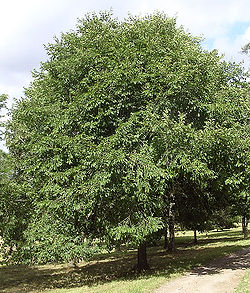Ulmus davidiana var. japonica
| Habit | tree
| |
|---|---|---|
| Height: | ⇕ | 100 ft"ft" can not be assigned to a declared number type with value 100. |
| Width: | ⇔ | 60 ft"ft" can not be assigned to a declared number type with value 60. |
| Lifespan: | ⌛ | perennial |
| Exposure: | ☼ | sun |
|---|---|---|
| USDA Zones: | 5 to 9 |
|
Ulmaceae > |
Ulmus > |
japonica > |
Ulmus davidiana var. japonica Rehder, the Japanese Elm, is one of the larger and more graceful Asiatic elms, endemic to much of continental north-east Asia and Japan, where it is most commonly found growing in swamp forest on young alluvial soils.
Size and shape are variable, ranging from short trees bearing densely-branched broad crowns to tall, single-stemmed trees with narrow crowns [1]. The young shoots often bear corky wings, similar to those of the European Field Elm U. minor, to which it is closely related. The leaves are generally obovate, < 11 cm long, and with a coarse upper surface. The perfect, apetalous wind-pollinated flowers emerge in early spring, before the leaves. The samara, <15 mm long, is obovate to orbicular, occasionally hairy over its entire surface but more often glabrous [2][3].
Read about Ulmus davidiana var. japonica in the Standard Cyclopedia of Horticulture
|
|---|
|
Ulmus japonica, Sarg. (U. campestris var. japonica, Rehd.). Tree, to 100 ft., with a broad head and often more or less pendulous branchlets: young branchlets densely pubescent and rough with minute tubercles, pale yellowish brown, sometimes developing corky ridges: lvs. obovate or elliptic, acuminate, oblique at the base, scabrous and hairy above, pubescent beneath with slight axillary tufts of hairs, 3-5 in. long; pairs of veins 12-16; petiole 1/6 – 1/4 in. long, densely pubescent: fls. nearly sessile, tetramerous: fr. obovate-oblong, about 3/4 in. long, gradually narrowed toward the base, with an open notch at the apex; seed touching the notch. Japan, Manchuria, Amurland. — Intro. into the Arnold Arboretum in 1895; it has proved perfectly hardy there, grows rapidly, and promises to become a valuable ornamental tree.
|
Cultivation
Unlike many Asiatic species, Japanese Elm is tolerant of a mild, maritime climate with heavy winter rainfall. Specimens planted England in 1977 have grown very well on heavy clay in an open location.
Propagation
Pests and diseases
Natural populations of Japanese Elm have a low to moderate resistance to Dutch elm disease.
Varieties
Ulmus × mesocarpa, a natural hybrid of U. davidiana var. japonica and Ulmus macrocarpa was discovered in South Korea in the 1980s [4].
The Japanese Elm was widely used in the USA in hybridization experiments at the Morton Arboretum and University of Wisconsin [5][6], resulting in the release of the following cultivars: Cathedral, Morton (Accolade), Morton Glossy (Triumph), Morton Plainsman (Vanguard), Morton Red Tip (Danada Charm), Morton Stalwart (Commendation), New Horizon, Patriot, Rebone, Repura, Revera, and Sapporo Autumn Gold.
The species has also been crossed with Dutch hybrids by the Istituto per la Protezione delle Piante (IPP) in Florence, Italy. Three clones are currently (2008) under evaluation in Italy, and England (by Butterfly Conservation): FL 601, FL 610 and FL 626.
The tree was assessed in Canada as a substitute for native elms which had succumbed to Dutch elm disease. A number of particularly hardy cultivars were released there in the 1980s; two cultivars were also raised in the USA[2]: Discovery, Emerald Sunshine (formerly treated under U. propinqua Koidz.), Freedom, Jacan, Mitsui Centennial, Prospector (formerly treated under Wilson's Elm U. wilsoniana C.K. Schneid.), and Thomson [7]. However, most of the Canadian clones have now been withdrawn from commerce owing to the Canadian government's restrictions on the movement of elm within the country, adopted to prevent the spread of Dutch elm disease.
Gallery
References
- ↑ Heybroek, H. M. (1981). The Japanese elm species and their value for the Dutch elm breeding program. Proceedings of the Dutch Elm Disease symposium and workshop. October 5–9, 1981, Winnipeg, Manitoba. pp 78–90
- ↑ Heybroek, H. M. (1981). The Japanese elm species and their value for the Dutch elm breeding program. Proceedings of the Dutch Elm Disease symposium and workshop. October 5–9, 1981, Winnipeg, Manitoba. pp 78–90.
- ↑ Fu, L., Xin, Y. & Whittemore, A. (2002). Ulmaceae, in Wu, Z. & Raven, P. (eds) Flora of China, Vol. 5 (Ulmaceae through Basellaceae). Science Press, Beijing, and Missouri Botanical Garden Press, St. Louis, USA [1]
- ↑ Kim, M., & Lee, S. (1989). Korean J. Pl. Taxon. 19(1) (1989)
- ↑ Santamour, J., Frank, S. & Bentz, S. (1995). Updated checklist of elm (Ulmus) cultivars for use in North America. Journal of Arboriculture, 21:3 (May 1995), 121-131. International Society of Arboriculture, Champaign, Illinois, USA
- ↑ Smalley, E. B. & Guries, R. P. (1993). Breeding Elms for Resistance to Dutch Elm Disease. Annual Review of Phytopathology Vol. 31 : 325-354. Palo Alto, California
- ↑ Burdekin, D. A. & Rushforth, K. D. (revised by Webber, J. F., 1996). Elms resistant to Dutch elm disease. Arboricultural Research Note 2/96. Arboricultural Advisory & Information Service, Alice Holt Lodge, Farnham, England.
External links
- w:Ulmus davidiana var. japonica. Some of the material on this page may be from Wikipedia, under the Creative Commons license.
- Ulmus davidiana var. japonica QR Code (Size 50, 100, 200, 500)
